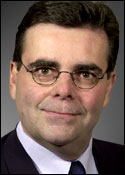Feb 09, 2004EPCglobal's User Action Group (UAG) is emerging as the focal point for EPC Network standards and pilot and implementation activity. Companies that want to take part in driving standards and sharing learning around EPC implementations should consider joining the UAG, as well as EPCglobal's Technical Action Groups, which develop and test the technical standards.
Although the UAG is only four months old, we already have more than 250 individual members, representing more than 40 end-user organizations, as well as numerous technology vendors, and standards and research organizations associated with EPCglobal and Auto-ID Labs. The UAG has met three times as a group, most recently in New York City on Jan. 14 and 15—and formed nine working groups, which are in various phases of start-up. These cover broad areas of strategy, technology and adoption.
The UAG's mission is to deliver end-user business requirements to the EPCglobal standards development process and to drive adoption of the EPC Network. We have already detailed the business requirements around Class 1 Generation 2 tags. But there are two things about this work that are important to understand:
ß The EPCglobal standards development process is end-user-driven. That is, companies such as Kimberly-Clark, which must use the technology, will join to drive the business requirements of the technology.
ß Standards are only of value when they are used. That’s why the development of the technical standards and the broad implementation and use of these standards are inextricably intertwined.
In the end, what the EPCglobal standards development organization is delivering are technical standards supporting the interoperability of components around the EPC Network “stack”—such as tag data, air interface protocols, the object name service and so forth. The “physics” of these standards will get developed by the Technical Action Groups of EPCglobal. This is important in how the UAG structures its work.
As end users, it’s our job to communicate to the Technical Action Groups something like: “We expect to use the EPC Network for X particular business applications, and to perform these business applications appropriately, we have Y requirements of the network, such as read range, read rates, EPC data needs and so on.” We’ve adopted a disciplined “use case” approach to how we will communicate these business needs to the Technical Action Groups.
Use cases clearly lay out the application we want to use the EPC Network for. The application can be narrow, such as “pallet receipt” or something broad, such as “track and trace.” Once we identify the business application, we then map out the business process surrounding the use of the network, create sequence diagrams and lay out specific performance requirements. With a use case, the Technical Action Groups can then appropriately develop and test the technical standards, and the end users can evaluate these proposed standards against the use case.
The User Action Group will also be the primary venue for the EPCglobal end-user community to help drive adoption of the EPC Network. We’ve just started the Pilot and Implementation Working Group, which will be the centerpiece of this effort. This group’s objective will be to share implementation learnings, profile vendors, report on and scorecard pilots, and develop implementation roadmaps for members
One key challenge that Erwin Veer of food retailer Ahold and I, as co-chairs of the UAG, along with EPCglobal's Chris Lemmond, will have is to extract all the information we can from companies currently piloting and planning to pilot EPC technology. This is necessary so that we can use the appropriate metrics to measure adoption, solicit implementation commitments and communicate the value proposition to the EPCglobal community.
I strongly encourage end-user companies to subscribe to EPCglobal and identify senior EPC/RFID solutions professionals to participate in the User Action Group. But don't expect a free ride. Just recently we’ve instituted strict participation requirements: If you want to be a UAG member and come to meetings, you have to be an active member of a working group. That said, if you’re interested in participating, please feel to contact either me at
mdoshea@kcc.com, Erwin Veer at
Erwin.veer@ahold.com, or Chris Lemmond at
clemmond@epcglobalus.org. Together, we can build the infrastructure for a collaborative global supply chain.
Mike O’Shea is the director of corporate auto-ID/RFID strategies and technology at Kimberly-Clark Corp.


